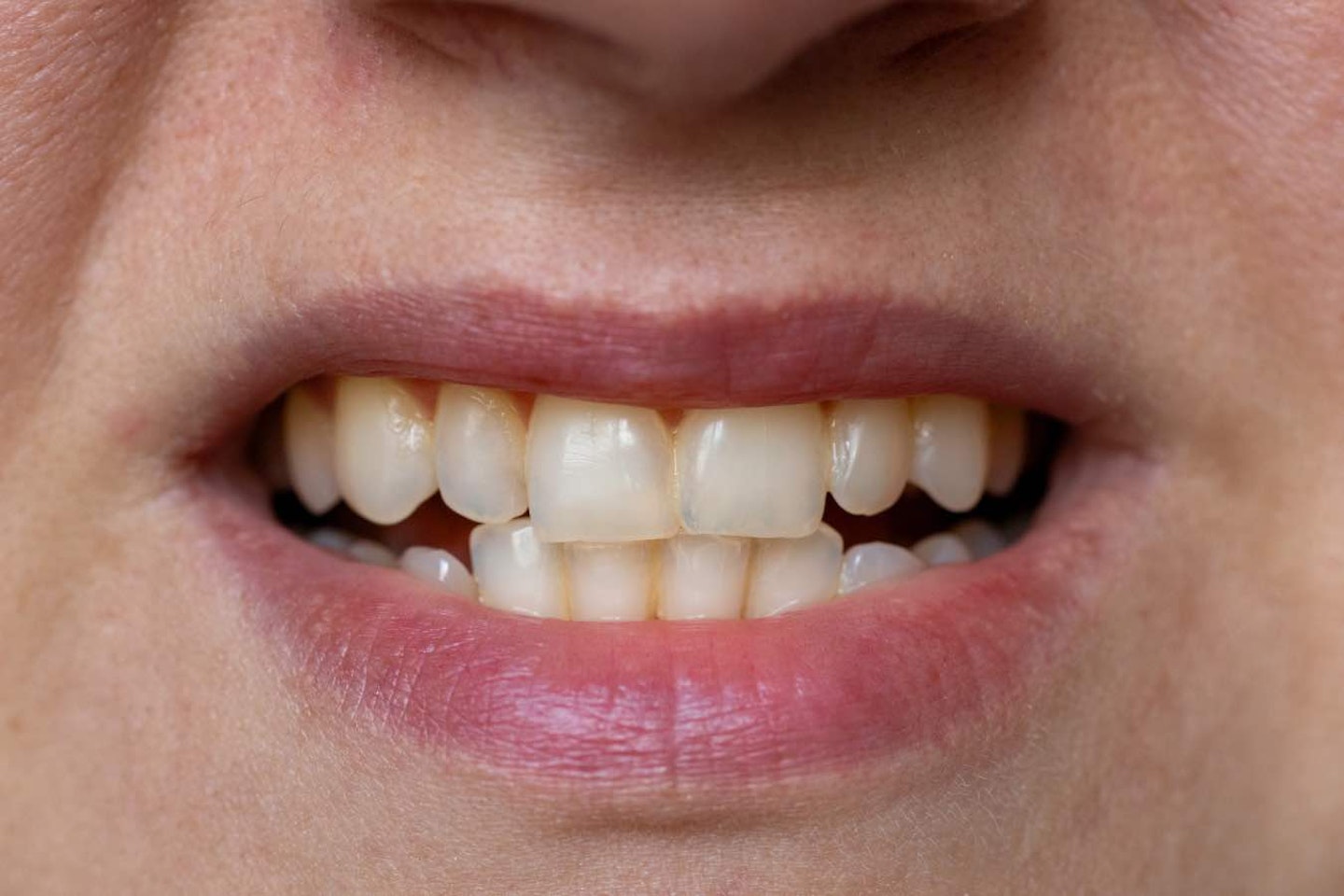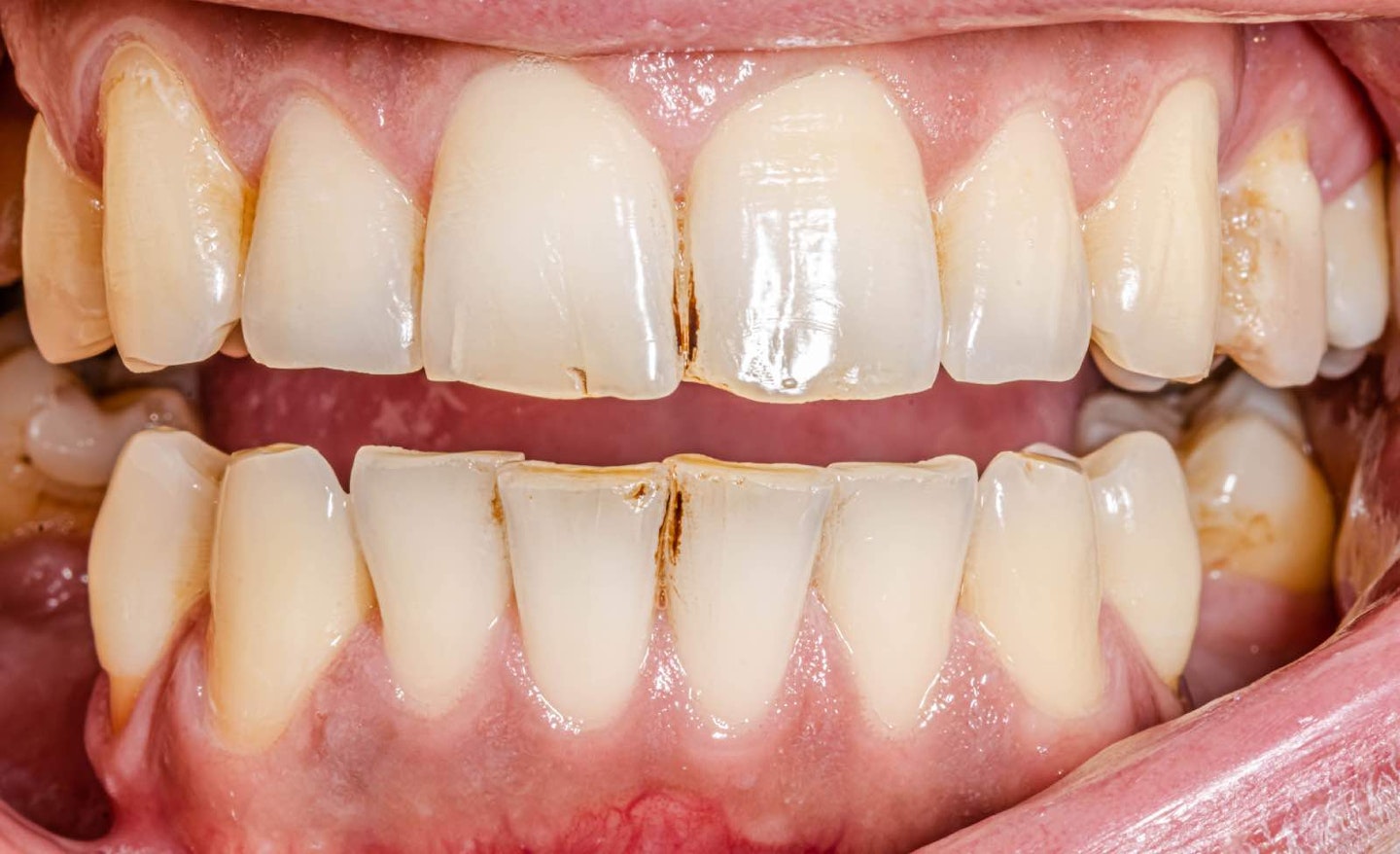Does a white smile mean strong teeth? A dentist explains what the shade of your teeth says about your wellbeing.
The rise in products that aim to make our smiles brighter, and new treatments such as veneers, composite bonding and whitening shows that there is an appetite for a gleaming smile.
‘It’s true that white teeth are associated with looking good,’ says cosmetic dentist, Dr Joe Bansal of londonsmiling.com. ‘Tooth whitening is one of the most requested treatments from my patients. However, the colour of teeth and the markings on them don’t simply show how often you use your toothbrush.’
Here Dr Joe explains what the colour of your teeth really reveal.
Yellow teeth

The good news is, yellow teeth does not necessarily mean your dental health is poor. It’s often simply a symptom of ageing and menopause can also affect teeth. ‘You may have noticed your teeth look less bright as you’ve got older,’ says Dr Joe. ‘The tooth is made of enamel on the outside and something called dentine on the inside. Over time, the enamel can wear thin, letting the more yellow dentine show through. Drinking acidic drinks like juices, tooth grinding, and general wear and tear all contribute to this gradual change. Genetics also plays a part.’
Grey teeth
‘Tooth colours are usually a mix of different shades of white and yellow,’ says Dr Joe. ‘But there’s always some genetic variation so you can get kind of different tints of teeth. Greyness in teeth can be caused by acidic drinks, such as fruit juices, or stomach acid reflux. Acids mean you get tooth wear not only from the front surface but from the back surface too. This means the edges become quite thin, giving that grey appearance.’ If one tooth has turned grey this could be a sign of trauma. ‘You may notice one tooth turning grey after an incident, such as a knock or sports injury, Trauma can cause a tooth to die off (known as necrosis, when too little blood flows to the tissue causing it to die), and it will change colour,’ explains Dr Joe. ‘You should seek advice from your dentist, who may be able to rescue it with root canal treatment.’
Pink teeth
Tooth gone pink? ‘If you've had a knock, occasionally the body will attempt to reabsorb the tooth, and it may go pink instead of falling out,’ explains Dr Joe. ‘That's because the pulp nerve is bleeding into the tooth and the body is reabsorbing it, either from the outside (external resorption) or inside (internal resorption). Root canal treatment can help, as you're then cleaning the tooth from the inside. If the tooth is discoloured, you can choose to have it whitened. However, to ensure uniformity it may be better to do the whole set of teeth.’
Brown teeth
Has a single tooth gone brown and glassy? ‘A condition called sclerotic dentine causes the tooth to appear brownish and smooth,’ says Dr Joe. ‘The tooth that has become "plugged up" and hardened due to mineral deposits, either as a natural part of ageing or as a defence mechanism against decay and other damage. That can be sorted out with the latest dental techniques.
Teeth with brown marks

‘Brown streaks are caused by fluorosis, which is caused by consuming excessive fluoride during certain stages of tooth development in childhood,’ explains Dr Joe. ‘It’s not common in this country. Some parts of the world, such as some African countries, have lots of fluoride in their water naturally. So often adults will have yellow banding or patterns on their teeth. This can be treated with whitening techniques, but we might go lower in terms of peroxide strength and get results more slowly.’
If you have flecks or teeth that have brown pits, it could be due to medication received in childhood. ‘For people who were treated with tetracycline antibiotics as children in the late seventies and early eighties, the medications caused binding to calcium, resulting in yellow, brown, or greyish permanent teeth. It can be treated with whitening, and in severe cases, we can try porcelain veneers to cover the teeth.’
Teeth with white spots
Certain medicines and illnesses that occur in early childhood can sometimes cause enamel hypoplasia – a change in the way enamel is formed causing white spots or white lines on the teeth. ‘This can be quite easily treated by tooth whitening and other techniques, almost as you would do a chemical peel for the face,’ says Dr Joe. ‘We use micro-abrasion, and resin infiltration which reinforces tooth enamel.’ Other irregularities may be caused by poor oral hygiene when wearing a brace. ‘If you’ve not been brushing your teeth properly, plaque forms around the brackets,’ he says,’ When the brackets are finally taken off, you get these little square boxes on your teeth where the plaque has acidified the outer layer. Caught early enough, it can be treated quite easily.’
Green teeth
It sounds like the stuff of nightmares, but Dr Joe says green teeth are possible. ‘Thankfully it’s rare – I have never seen it in my career,’ he says. ‘It’s something you see it in the textbooks. It’s caused by having jaundice or liver problems as a baby or as a young. There is an excess of bilirubin (a yellow pigment) that results in them being green. The good news is, once their adult teeth come through, they should be normal.’
White teeth - healthy or not?

If you’re the proud owner of a naturally white teeth, lucky you – but Dr Joe warns it doesn’t necessarily correlate to how healthy your dental health is. ‘Conversely, I can get patients who've got quite yellow teeth and are doing all the right things, and have extremely healthy teeth,’ he says. ‘Good oral hygiene is – such as brushing your teeth three times a day with an electric toothbrush and removing tartar– is still important.’
How to get white teeth
If you’re not naturally blessed with a gleaming smile, dentists can help. ‘You can buy gels over the counter on online, but dentists will prescribe the most suitable and safe gel for your teeth and makes the best-fitting mould,’ says Dr Joe. ‘We take scans, which are the modern way of taking impressions, so no need for putty. From these, we make a close-fitting gum shield for your teeth which holds a whitening gel against your teeth until you’re happy with the shade. Most teeth whitening gels from the dentist will contain hydrogen peroxide. When the peroxide is activated, it pushes oxygen through the tooth to whiten the teeth from the inside. If the trays are not snug against the teeth, the gel leaks out, and saliva can leak in. Beware of unregulated online whitening products as research has shown many contain potentially dangerous levels of hydrogen peroxide.’
Dr Joe Bansal is a cosmetic dentist at londonsmiling.com
Lucy Hunter is a senior content creator across different titles, such as Bella, Take a Break, and of course yours.co.uk. After three decades in journalism, she’s covered just about everything – from travel and true-life stories to health and emotional wellbeing – and still loves uncovering the human angle in every subject.
